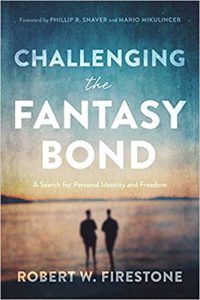Challenging the Fantasy Bond
In this blog, Dr. Robert Firestone shares the introduction and conclusion from his new book, Challenging the Fantasy Bond.
In this blog, Dr. Robert Firestone shares the introduction and conclusion from his new book, Challenging the Fantasy Bond.
By Dr. Robert Firestone
 The Glendon Association is pleased to announce the publication of Challenging the Fantasy Bond, a timely revision of Dr. Robert Firestone’s popular book, The Fantasy Bond, which was first published in 1985. Over the last few years, the staff at the Glendon Association has been encouraging Robert Firestone to update The Fantasy Bond, but his interest in writing new books and articles kept him from taking on the task. Then, in early 2020, when the world suddenly shut down and he had to quarantine to avoid Covid, Bob began looking for a project to take on during the pandemic, and Glendon’s request came to mind.
The Glendon Association is pleased to announce the publication of Challenging the Fantasy Bond, a timely revision of Dr. Robert Firestone’s popular book, The Fantasy Bond, which was first published in 1985. Over the last few years, the staff at the Glendon Association has been encouraging Robert Firestone to update The Fantasy Bond, but his interest in writing new books and articles kept him from taking on the task. Then, in early 2020, when the world suddenly shut down and he had to quarantine to avoid Covid, Bob began looking for a project to take on during the pandemic, and Glendon’s request came to mind.
In the Spring of 2020, Bob put together a team to work with that included his original collaborator, Joyce Catlett, his daughter, psychologist Lisa Firestone, and his usual editors, Jo Barrington and Tamsen Firestone. The five of them revised The Fantasy Bond with the mission of bringing The Fantasy Bond into the 21st century. By the summer of 2021, Challenging the Fantasy Bond was complete and, by early 2022, APA had published it.
The organization and purpose of the book mirrors the original; to elucidate the fundamental theory of the fantasy bond. The first section introduces the fantasy bond and includes information about the fantasy bond in relation to Separation Theory and then in relation to couples and families. The second section discusses the dimensions of the fantasy bond, including the idealization process within the family as well as one’s negative self-concept. The third section explores the behavioral manifestations of the fantasy bond which have deleterious effects on individuation. This includes a discussion regarding unfulfilling inwardness, withholding and regression, as well as the impact of the fantasy bond on one’s sexuality.
The Fantasy Bond has continued to sell well over the years, greatly helped by word-of-mouth, thanks to people like Marc Maron and his WTF podcast. While these readers have been benefitting from the ideas put forth in this classic work, they have also been having trouble identifying with examples that have become dated and old fashioned. The examples in Challenging the Fantasy Bond are new, and therefore more reflective of the population in today’s world, representing various sexual orientations, ethnicities, ages, occupations, and income groups.
In addition, Challenging the Fantasy Bond has the benefit of the last 35 years of research and developments in the realm of psychology and related fields. This new book includes the latest findings from the neurosciences, attachment theory, and terror management theory. During the years between the publication of these two books, Drs. Robert and Lisa Firestone have continued to research and to develop the concept of the critical inner voice, which has led to a further assessment and development of Voice Therapy methodology. These findings are presented in Challenging the Fantasy Bond.
The concluding section of Challenging the Fantasy Bond expands the concept of the fantasy bond by exploring it more broadly, applying it to the operations of society at large. In a discussion of theoretical issues, the last chapters examine the function of the fantasy bond as it relates to death anxiety, society and conformity, and, finally, polarization, prejudice, and warfare. In the Introduction, Robert Firestone writes,
This edition is especially timely because it identifies significant psychological and social factors, based on people’s defensive responses to existential fears, which contribute to malignant prejudice, warfare, terrorism and ethnic cleansing. Developing an understanding of the role played by the fantasy bond as a powerful defence against death anxiety that ultimately leads to polarization and divisiveness between groups and nations, may well be essential to human existence.
Publication Date: February 2022
 Dr. Zamir is the president of the Anxiety and Panic Disorders Clinic of Santa Barbara. He will join us this April for a CE Webinar on “Obsessive Compulsive Disorder: Key Principles of Exposure and Response Prevention (ERP).” Sign up now to join the live event or to receive a video recording after the webinar’s taken place.
Dr. Zamir is the president of the Anxiety and Panic Disorders Clinic of Santa Barbara. He will join us this April for a CE Webinar on “Obsessive Compulsive Disorder: Key Principles of Exposure and Response Prevention (ERP).” Sign up now to join the live event or to receive a video recording after the webinar’s taken place.
A: OCD does run in families and twin studies indicate a high degree of genetic influence on whether someone will develop OCD. Researchers are even starting to determine specific genes that likely play a role in the development of OCD. See more here.
The environment can play a role in that highly stressful events can trigger OCD symptoms for someone who is already susceptible to OCD. High stress situations can also trigger relapse in someone who has achieved remission from OCD.
A: I have found this book useful for conceptualizing OCD and having a simple and straightforward plan for dealing with OCD. I think it could be a useful adjunct to therapy. I have also found the books Overcoming Unwanted Intrusive Thoughts to be very useful for people to use during treatment for OCD with ERP to increase understanding and progress.
A: This is not necessary and likely to be misleading. There is no evidence that OCD is caused by childhood trauma. We have effective methods for treating OCD that get at the root of the problem. These methods address the core aspects of OCD. OCD is a highly heritable condition and childhood trauma does not appear to be the primary driver of OCD symptoms.
A: For some people OCD can be related to fear of death or fear of other bad things happening. ERP addressed this directly and would involve exposure to these fears and the development of greater tolerance of things that are outside of our control. ERP can help people to develop acceptance of things that are outside of their control and to help them to habituate to anything that they are afraid of. Additionally, it helps them to develop greater tolerance of uncertainty and less reactivity to fearful thoughts.
A: I think it would be misguided to see intrusive thoughts related to OCD as a critical inner voice. These intrusive thoughts have a different origin and are fundamentally different than self-critical thoughts. That being said, people with OCD are often highly conscientious and they may be more prone to negative self-talk. When this is the case, these critical thoughts also need to be addressed.
A: In the event described above where someone has negative self-talk in addition to OCD, voice therapy or cognitive therapy interventions may be necessary to address these self-critical thoughts.
A: While these are not necessarily related to OCD, there are related methods of exposure therapy that can be used to treat phobias in kids and adults. Gradual exposure or systematic desensitization to feared stimuli can help people to overcome their fears and phobias.
A: I don’t tend to see a lot of anger, as I attend to building a strong therapeutic relationship with my clients. I also help them to have a clear conceptualization of their OCD such that they are highly motivated to eliminate avoidance, compulsions, and safety behaviors that maintain their OCD. I develop collaborative treatment plans with clients and get their buy in early so that they are the ones pushing for change and helping to identify their own behaviors that need to be changed in order for them to gain relief from their OCD
It’s impossible to overstate the way this pandemic has changed our lives. Chances are, at this very moment, you are right smack in the middle of that change yourself. Maybe you’re reading this article from your dining table when you’d normally be in your office. Maybe you’re cramming it in after a long day of supervising your kids on Zoom. Maybe you’re reading it because you’re worried about having to change jobs, or because you’ve moved, or because you haven’t been able to see certain friends or family in more than a year.
A universal truth on which most of us can agree is that pandemic fatigue is real. Despite this fact, crisis always has a way of unifying, strengthening, and making us more resourceful. So let’s talk about five ways to find meaning in the madness:
While there are real circumstances in our lives that are causing us concern, there are also real techniques we can and should use to calm down. It’s okay to give ourselves permission to seek a little bit of peace right now. Here are five ways to help you do it.
Watch an exclusive interview with Dr. Gia Marson on dealing with eating disorders during this difficult time.
In the United States, black people are almost guaranteed to be born into a life of trauma. It is a trauma informed by a long history of brutal inhumanity, repression, violence, and injustice that continues to firmly grip black men and women each and every day. This trauma is not something any of us who have not had the experience of being black in America can speak to in the same way as someone who has. Yet, acknowledging this trauma and casting it in a broad, unflickering light is all of our responsibility.
When Africans arrived in the New World, they weren’t allowed to read or write. Transmitting information orally was the only way that the slaves were able to retain their culture from generation to generation. Today, that oral tradition is reflected in storytelling, rap music, and spoken word performance. This type of expression is normatively accepted as non-threatening, as it is more insular to the African American community. But when issues related to racism, social justice, and personal truth have been voiced from a larger mainstream platform, there has typically been a white gatekeeping knee-jerk function in place to silence the commentary.
The current crisis we’re enduring with Covid-19 is taking a toll on more than our physical well-being. A recent Kaiser poll showed that nearly half of Americans feel the coronavirus crisis is harming their mental health. Suicide and crisis call and text hotlines have reported “unprecedented” spikes in the number of calls they receive, and many are concerned this could mean a rise in suicides.